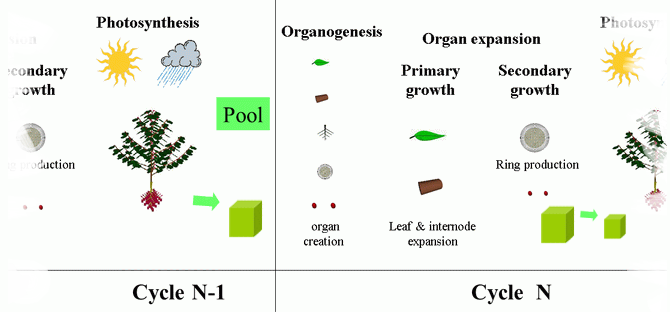GreenLab Course
Production-Expansion
Principles
Reminder: The growth cycle
-
A discrete model
-
THe GreenLab model evaluates plant structure and production at regular thermal time periods,
defined from an average daily temperature sum ratio, called a growth cycle (CG for cycle of Growth).
The growth cycle value, is usually low compared to a shoot development cycle. Hence:
* Thermal time implicitly controls the speed of plant development (organogenesis).
* Thermal time implicitly controls organ functioning and expansion durations.
* However, organ growth does not depend on temperature, but only on the available biomass to be shared with the other organs from a common biomass pool.
The growth and development cycle
* For each growth cycle, the model defines organogenesis evolution on a representative of each metamer organ cohort (since all organs in a given cohort share the same chronological and physiological properties).
* Biomass production is computed from organ sources and sizes (usually the functional leaf areas).
* If organogenesis occurs, new organ cohorts are created.
* Biomass demand is then evaluated, for each organ cohort, according to its sink strength value.
* The common pool of biomass is then spread among the available functioning organ cohorts, as a proportion if the demand exceeds the pool.
* The organ sizes are computed, from their chronological age, their expansion state, and allometry rules
* The remaining biomass, if any, is kept in the biomass pool.
The following figure illustrates this scheme.

The GreenLab dynamic model cycle (Illustration P. de Reffye and M. Jaeger, CIRAD)
For each growth cycle:
- 1 - Plant production is computed and stored in the biomass common pool
2 - Organogenesis is computed with potentially new organ cohorts
3 - Plant demand is evaluated and the required biomass split among the organs in proportion to their sink and the common biomass pool availability
